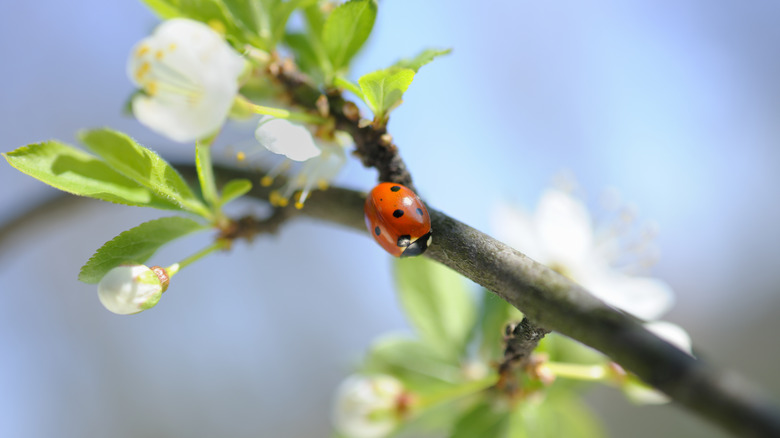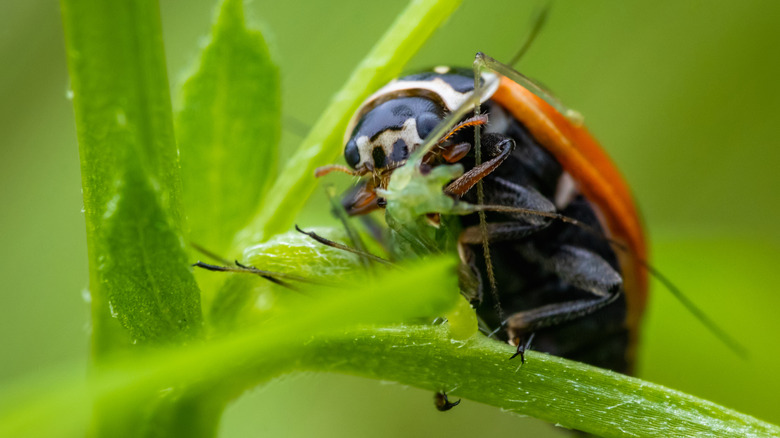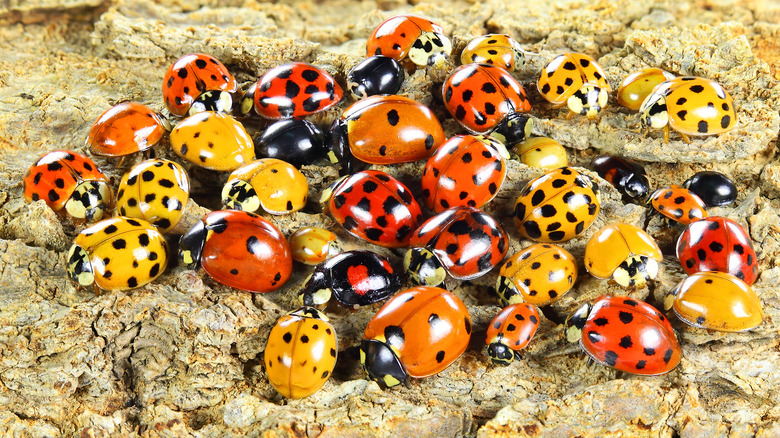Why Ladybugs Are Omens Of Luck In So Many Cultures
If any bug is likely to provoke delighted responses of, "Oh, look! Cute," rather than, "Oh God, kill it!" it's a ladybug. If a mosquito gets in the house, all of humanity would join in demanding its assassination. Same goes for cockroaches. Flies are annoying but pretty harmless, but if they keep landing on the cake it's death time. Silverfish are gross little things but easily dispatched, just like pill bugs. But ladybugs? Lots of folks might put down a finger to a ladybug in a house, say, "Come on, come on," let the thing crawl up, examine its little spots, and then find a window. And to many people ladybugs aren't just cute, they're bonafide symbols of good luck.
Bear in mind that any time we talk about omens, luck, fortune, fate, etc., we're veering 100% into superstition territory. There's obviously no actual, quantifiable, measurable consequence to seeing a ladybug in the home, outside of the home, in your dreams, in your garden, on your arm, whatever. But like many things, it's the psychological impact that matters. The Lucky Antler says that ladybugs are a big spiritual deal in China, for instance, where they represent the "five victory:" "courage, love, happiness, wisdom, and fertility." Some people even incorporate ladybug art into Westernized feng shui around the house. There is, however, a real reason that ladybugs might have gotten such a good, historical reputation — they're great in gardens and help keep crops pest free.
Destroyer of aphid worlds
Let's be honest: Ultimately, ladybugs are "good luck" because of their utility to human life and endeavors. The global aphid population, on the other hand, probably regards ladybugs as their goddess of death. Aphids are ladybugs' preferred food, same as aphids suck the liquid from stems and leaves. Aphids leave plants yellowed, shriveled, discolored, chewed up, and in large enough quantities leave behind a sticky residue that attracts ants that make the situation worse. Aphids also transmit viruses to plants and ruin them entirely. As the National Pesticide Information Center (NPIC) explains, each generation lives only about a month, but an aphid can produce 40 to 85 more aphids during that time. As a result, aphids can impact overall crop yield and quality, which puts human food supplies at risk.
This is where ladybugs, which chow down on aphids by the hundreds, come in. Some gardeners directly introduce ladybugs into gardens to consume aphids, while others attract them with water and plants. Sites like Niagara Frontier Publications talk about the moral complexities of introducing ladybugs in such a "violent, militarized way of controlling nature," but we're pretty sure most farmers don't care. And since agriculture forms the shared foundation of every single society across the globe, it stands to reason that ladybugs are universally well-regarded and considered "lucky."
Ladybug or lady beetle?
Ladybugs don't just eat aphids — they eat spiders, mealworms, and the eggs of other destructive insects that destroy potatoes and corn. Sometimes ladybugs will eat pollen and nectar, or ladybug larvae will eat other ladybug eggs, but that's only if they're desperate for food. And yet, National Geographic tells us that there are over 5,000 species of ladybugs — ladybirds as they're sometimes called — worldwide, so there's a lot of variation to be found beyond the typical, round, red-with-black-spots variety. Some ladybugs — beetles of the family Coccinellidae, technically — are not as benign as others. These are what we might call ladybugs of ill omen.
Specifically, we're talking about the Asian lady beetle (Harmonia axyridis), which looks extremely similar to our happy aphid-devouring ladybug, but can be distinguished by a black "M" shape on the white part of the top half of its body. Lady beetles are an invasive species and leave behind a bad-smelling, gooey yellow substance on surfaces. Unlike their cute brethren and sistren, they also bite. As the name implies, this insect is native to various Asian countries but found its way overseas from the 1960s to 1990s, per the University of Kentucky. So the next time you see a ladybug, take care and interpret the signs. If you didn't notice the "M" on the back and got some smelly yellow goo on you, then you definitely got unlucky.


